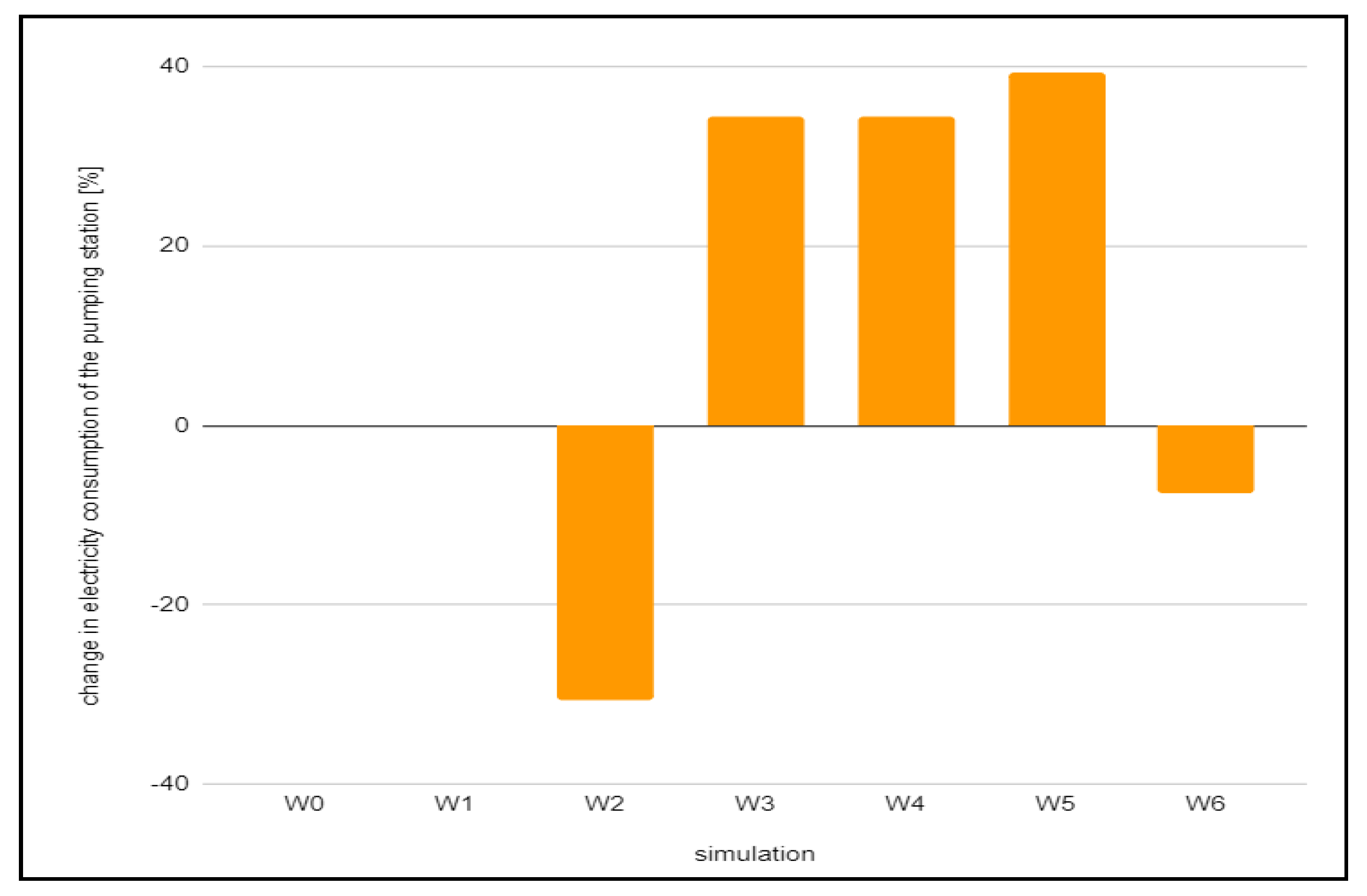Energy Optimization of the Pumping Station †
Abstract
:1. Introduction
2. Material and Methods
3. Results and Discussion
- +/−5.0% at pressure measurement points;
- +/−2.5 m H2O for hydrant tests.
- Connecting the sectors with a new pipe;
- Reduction in the outlet pressure from the pump station;
- Increasing the outlet pressure from the pump station;
- Adding an additional pump to the pump station.
4. Conclusions
- The value of the outlet pressure from the pumping stations had the greatest impact on the electricity consumption of the pumping station;
- The connection of the network sectors did not change the electricity consumption in the pumping station;
- Adding an additional pump resulted in an increase in electricity consumption by the pump set;
- Connecting the sectors with a new pipe allowed reduction in the pressure at the outlet of the pumping station.
Author Contributions
Data Availability Statement
Conflicts of Interest
References
- Naval, N.; Yusta, J.M. Water-Energy Management for Demand Charges and Energy Cost Optimization of a Pumping Stations System under a Renewable Virtual Power Plant Model. Energies 2020, 13, 2900. [Google Scholar] [CrossRef]
- Cimorelli, L.; Covelli, C.; Molino, B.; Pianese, D. Optimal Regulation of Pumping Station in Water Distribution Networks Using Constant and Variable Speed Pumps: A Technical and Economical Comparison. Energies 2020, 13, 2530. [Google Scholar] [CrossRef]
- Luna, T.; Ribau, J.; Figueiredo, D.; Alves, R. Improving energy efficiency in water supply systems with pump scheduling optimization. J. Clean. Prod. 2019, 213, 342–356. [Google Scholar] [CrossRef]
- Świętochowski, K. Modelling of pressure management in reducing water losses. Technol. Wody 2020, 2, 8–13. [Google Scholar]
- Biatech Ltd. Hydro-Test: Users Manual; Biatech Ltd.: Zaścianki, Poland, 2020. [Google Scholar]
- Świętochowski, K. The impact of testing fire hydrants on water loss. Instal 2018, 11, 41–43. [Google Scholar]
- Rossman, L.A. EPANET 2: Users Manual; U.S. Environmental Protection Agency: Cincinnati, OH, USA, 2000.
- Walski, T.M.; Chase, D.V.; Savic, D.A.; Grayman, W.; Beckwith, S.; Koelle, E. Advanced Water Distribution Modelling and Management; Haestad Press: Waterbury, CT, USA, 2003. [Google Scholar]

Publisher’s Note: MDPI stays neutral with regard to jurisdictional claims in published maps and institutional affiliations. |
© 2021 by the authors. Licensee MDPI, Basel, Switzerland. This article is an open access article distributed under the terms and conditions of the Creative Commons Attribution (CC BY) license (https://creativecommons.org/licenses/by/4.0/).
Share and Cite
Świętochowska, M.; Bartkowska, I.; Gwoździej-Mazur, J. Energy Optimization of the Pumping Station. Environ. Sci. Proc. 2021, 9, 37. https://doi.org/10.3390/environsciproc2021009037
Świętochowska M, Bartkowska I, Gwoździej-Mazur J. Energy Optimization of the Pumping Station. Environmental Sciences Proceedings. 2021; 9(1):37. https://doi.org/10.3390/environsciproc2021009037
Chicago/Turabian StyleŚwiętochowska, Martyna, Izabela Bartkowska, and Joanna Gwoździej-Mazur. 2021. "Energy Optimization of the Pumping Station" Environmental Sciences Proceedings 9, no. 1: 37. https://doi.org/10.3390/environsciproc2021009037
APA StyleŚwiętochowska, M., Bartkowska, I., & Gwoździej-Mazur, J. (2021). Energy Optimization of the Pumping Station. Environmental Sciences Proceedings, 9(1), 37. https://doi.org/10.3390/environsciproc2021009037





